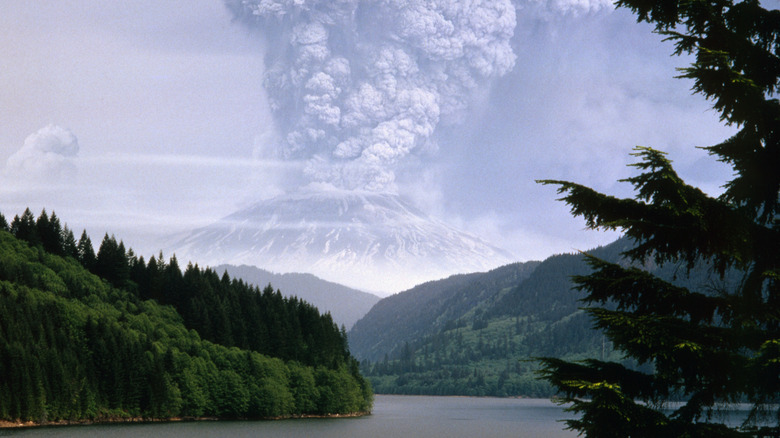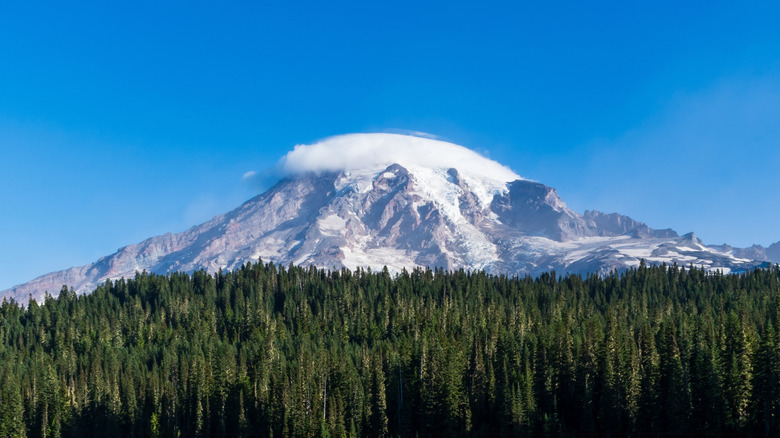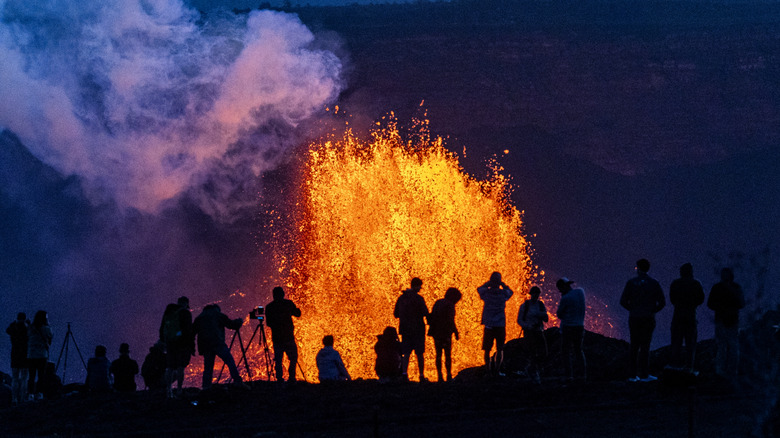Volcanoes Are Rumbling In These 4 States And 3 Are On The 'Ring Of Fire'
Triggering earthquakes and spewing magma and hot ash out of the ground, volcanoes are known for producing some of the most catastrophic natural disasters. These mountains are typically formed by plate tectonics and the stress it puts on the Earth's crust. While this activity can be unpredictable, the U.S. Geological Survey monitors seismicity to help mitigate the effects as much as possible. For the first half of 2025, it has recorded an increased amount of tremors and lava spewing from U.S. volcanoes, one in Hawaii, and five along the Ring of Fire in Alaska, Washington, and Oregon.
The Ring of Fire is the world's most active zone for earthquakes and volcanoes because it's the confluence of numerous tectonic plates. Alaska's southern coast is part of this ring, and three of its volcanoes have been especially active this year. The Great Sitkin volcano in the Aleutian Islands has actually been erupting since May 2021. As of July 17, it was still spewing lava slowly from its summit crater, which has continued to be accompanied by occasional low-level earthquakes.
Meanwhile, Mount Spurr on the mainland started experiencing a bout of activity in March. The Alaska Volcano Observatory (AVO) reported higher-than-usual levels of volcanic gas emissions, persistent tremors and deformations in the ground, and new developments in its Crater Peak vent. That sparked warnings of a likely eruption, but that risk significantly lowered in June — although low-level unrest continues. Additionally, the Mount Iliamna, 90 miles south of Mount Spurr, has been dormant for more than 100 years — last erupting in 1867 — but a flurry of rumbling was detected for several hours on June 15. Geologists didn't see any surface activity, though, and on July 1, the AVO set the alert code to normal for the volcano.
Volcanic activity in Washington and Oregon
If you follow a map of the Ring of Fire south from Alaska, you'll see that the western coasts of Washington and Oregon are located on it. Mount St. Helens in Washington was the deadliest and most destructive volcanic eruption in U.S. history, but the peak currently exhibiting activity is Mount Rainier just 40 miles southeast of Tacoma. On July 8, it started experiencing its largest earthquake swarm ever recorded. This cluster of hundreds of tremors — more than 700 compared to the typical nine per month — occurred in rapid succession, reaching up to magnitude 2.4 on July 11. Although there have been earthquakes through July 18 (and they are likely to continue), they're so small and far beneath the surface that they can't be felt, and the alert code remains set to normal with no imminent threat.
About 300 miles off the coast of Oregon, the Axial Seamount is around 5,000 feet underwater and the most active volcano in the region. Its last eruption — yes, underwater volcanoes can erupt — was in 2015, spewing lava across several miles of the Pacific Ocean floor. For months, it has been exhibiting increased earthquake activity and inflation from magma buildup, attracting a lot of attention from scientists who believe it's only a matter of time before another eruption occurs. Since it's so far underwater, though, it's not a threat to the state's communities on the coast. Oregon State University volcanologist Bill Chadwick told Oregon Public Broadcasting, "Inflation (of the volcano's surface) is marching along at a fairly steady clip ... but the rate of EQs (earthquakes) is down a bit lately."
Volcanic activity in Hawaii and what it all means
While the volcanoes in Alaska, Washington, and Oregon are located along the Ring of Fire, the volcanoes in Hawaii are in a different category. The island state actually sits at the southeast end of a chain of volcanoes created by a mantle plume, a hot spot where magma builds up in Earth's mantle — similar to why Iceland has so many volcano eruptions.
One of the world's most active volcanoes, Kīlauea in Hawai'i Volcanoes National Park, is currently under an orange watch alert code because it has been erupting almost weekly since December 2024. The first eruption lasted for 14 hours on December 23, and just 16 hours later on Christmas Eve, the second eruption started and lasted 27 hours. On May 25, the 23rd event (and a major one) began and lasted for just six hours but sent a plume of lava and ash 1,000 feet into the air. Since Kīlauea is about 200 miles from Honolulu, there's no imminent threat to life.
What does all of this volcanic activity mean? Fortunately, geologists say that there's no reason to worry and there's no correlation between the activity. USGS Earthquake Science Center seismologist Natalia Ruppert told USA Today, "Volcanoes can be unpredictable, and there's always the chance that something bad will happen, but these recent seismic events along the Pacific Ring of Fire from Alaska to Washington to offshore Oregon are probably not directly related to each other." She noted that volcanoes "come to life for a while" and that "sometimes the earthquake activity leads to an eruption and sometimes it doesn't." Plus, "the distance between these (seismic) activity centers is thousands of miles."


